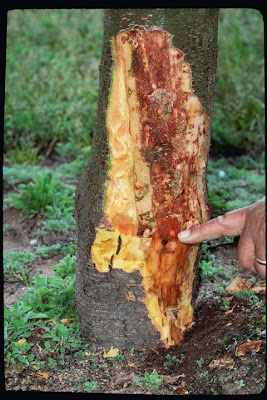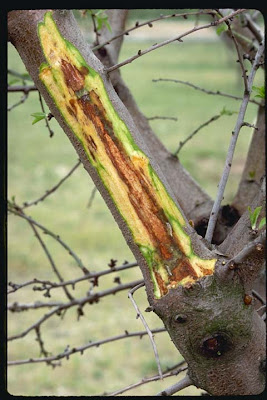Inquiries about Bacterial Canker on Almond
This week I have had a few questions regarding post harvest treatments for Bacterial Canker of almond. I thought it would be a good idea to use these questions as the theme for this weeks post.
What is bacterial canker?
Bacterial canker is commonly found on Prunus species (Peach, cherry, apricot, plum, almond, etc.). Caused by Pseudomonas syringe, a common surface inhabiting bacteria, the disease is often observed in the spring. Symptoms include limb dieback with rough, irregular cankers (Figure 1). Cankers do not extend into the soil and a very unique smell is present. In some cases, cankers do not form, but a "sour sap" stage occurs. This stage is characterized by brown inner bark with a distinctive fermentive, sour smell - hence the name. Generally, almond trees in the 2nd through 5th leaf are affected.
 Figure 1: Almond tree killed by bacterial canker. Note that the canker has an irregular shape and does not extend into the soil.
Figure 1: Almond tree killed by bacterial canker. Note that the canker has an irregular shape and does not extend into the soil.
How does bacterial canker spread?
Pseudomonas syringe survives on plant surfaces and is spread by splashing rain. The bacteria is found throughout the entire orchard and is impossible to eradicate. The disease commonly occurs in the spring during periods of mild temperatures and high humidity. It does not spread like other diseases, but is common on trees that are stressed. Therefore, soils that have poor water/nutrient holding capacity (i.e. sand), have been replanted with several generations of Prunus sp. orchards, and have the presence of ring nematode are prone to this disease.
 Figure 2: Photo of an almond with a scaffold infected with bacterial canker. Note the irregular margin of the canker.
Figure 2: Photo of an almond with a scaffold infected with bacterial canker. Note the irregular margin of the canker.
What can I do to prevent the problem?
In soils that have exhibited the disease, pre-plant fumigation with Telone or Methyl Bromide (if it is still available) provides the ability for the tree to establish a healthy root system while it is young. This is mainly due to reduction of nematodes and replant disease. It is important to note that nematodes will still find their way to the roots as fumigation does not kill all of the nematodes in the soil. In this case, fumigation serves as a means to "buy time" before the soil surrounding the tree becomes re-infested.
All the almond rootstocks differ in their susceptibility to the disease, which is due to their ability to be parasitized by the ring nematode. Marianna 2624 and peach almond hybrids (Brights, Hansen, etc.) are more susceptible than Nemaguard, Lovell, and Viking. Lovell and Viking are the most resistant.
Studies by Roger Duncan in Stanislaus County have demonstrated that low biuret urea foliar sprays made BEFORE leaf drop can reduce the incidence of bacterial canker. Duncan's research showed that a foliar spray with 100 lbs/acre of low biuret urea applied to unfumigated trees gave the same level of bacterial canker control as pre-plant soil fumigation with methyl bromide. It is unknown if 100 lbs/acre are needed, but it is clear that a fall foliar spray of nitrogen is helpful in preventing bacterial canker. It is thought that the additional foliar nitrogen reduces tree stress, thus increasing resistance to bacterial canker.
Since the disease is correlated with infestation by the ring nematode, fall treatments of Enzone nematicide have also been shown to be effective. Recently, the systemic insecticide Movento was released. This product has been shown to reduce lesion nematode populations in walnut, but studies have not been carried out in almond.
Do copper dormant sprays reduce bacterial canker?
The short answer is no. In all of the studies held in California since the 1960's within bacterial canker, copper sulfate dormant sprays have given very inconsistent results. It would be better to save the money by not applying copper and use it for either a fall nitrogen foliar spray or application of a post-plant nematicide.
